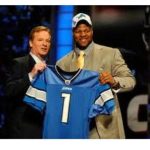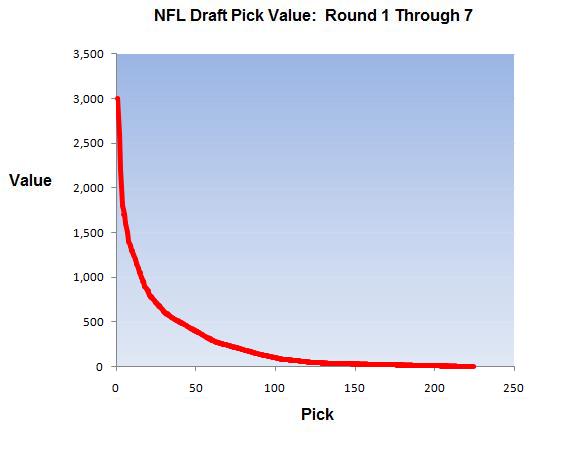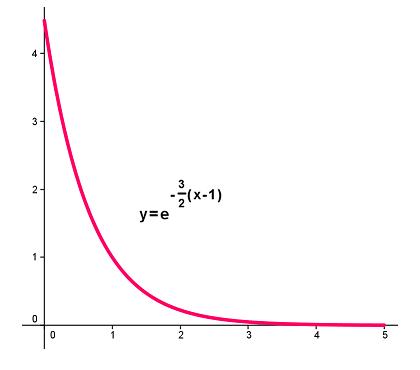NFL Draft Math
 There’s a lot of mathematics going on in the NFL Draft. Here’s one example.
There’s a lot of mathematics going on in the NFL Draft. Here’s one example.
In the National Football League’s player draft, every franchise is allotted one pick per round to select draft-eligible players for their team. The initial draft order is determined by the prior year’s standings, with the last year’s worst team (by record) picking first each round.
The opportunity to select a player is a valuable asset, and picks are often traded among teams before, or during, the draft. Teams might look to trade up to obtain an earlier pick (in order to select a coveted player), or trade down to get extra picks in the later rounds (turning one high pick into two or more low picks).
An interesting mathematical question is “What is Draft Choice N worth?” It’s easy to say that the first overall pick is worth “a lot”, and the second pick overall is worth “slightly less”, but how can position in the draft really be quantified?
It turns out that football analysts have created a trade value chart that essentially standardizes the value of picks . For example, a team holding the 7th overall pick, valued at 1,500 points, might expect to receive the 21st pick (800 points) and the 26th pick (700 points) in return, were they to trade their pick. This conventional valuation helps establish fair prices for trades, as it would in any commodities market.
So what are the picks worth? I pulled the numbers from the trade value chart and created this graph.
The drop-off in value is steep: for example, the 1st overall pick is considered twice as valuable as the 7th overall pick; the 7th pick is twice as valuable as the 23rd pick, which is twice as valuable as the 52nd pick. There is no simple formula, but the graph above definitely suggests exponential decay:
It’s not clear why the model for draft pick valuation should resemble exponential decay (which describes radioactive decay and cooling to ambient temperatures, among other things), but the resemblance is clear.
It’s important to understand that this is merely a practical guide to draft position valuation. The real value of a draft choice depends not just on position, but on many other factors as well: the overall quality of available players, the needs of your team, the needs of your competitors, and contract issues, to name a few.
If you could figure out a more meaningful, or accurate, way to quantify these picks, you could probably help an NFL franchise get a leg up on the competition!
Related Posts
- NFL Draft Math: Analysis
- More NFL Draft Math: Pick 33
- NFL Draft Math: 2012
- NFL Overtime Rules and Strategy


9 Comments
sportsattitudes · April 26, 2011 at 8:36 am
Nice post and an interesting angle on the Draft process. Enjoyed the read.
MrHonner · April 26, 2011 at 8:49 am
Thanks! Here’s hoping we’ll be able to continue to analyze and enjoy the game next year.
David Shukhman · April 26, 2011 at 12:12 pm
I find this a very interesting post indeed. This actually seems like a very interesting term paper question. I never knew that there was any math involved in the draft selections.
emergentmath · April 26, 2011 at 2:14 pm
Great stuff. From all I hear the NFL Draft Pick values are kind of bogus. It would be interesting to test the alleged draft value chart with this, the actual traded picks:
http://adamjt13.blogspot.com/2009/04/nfl-draft-pick-trade-history.html
–Geoff
MrHonner · April 26, 2011 at 2:22 pm
Very interesting idea, Geoff: comparing the Value Chart against the actual trades that have been made over the years. Thanks for the link–there’s a lot of raw data in that post!
As to whether or not the Value Chart is bogus, I think it’s really just a rough guide. Each draft pick, like any commodity I guess, has a unique value determined by the circumstances of seller and buyer. But it’s an interesting quantitative exercise to ponder.
Geoff · April 27, 2011 at 12:32 pm
I think I might ponder it on my blog today, time permitting. It might be fun to have students either debunk (or possibly “bunk” (?) ) the Draft pick value chart.
The thing I’m wondering is how future draft picks are valued. It seems that according to teams, future draft picks have a smaller value than current ones. Teams will often trade significantly “higher value” picks for the following year in order to get “worse” current year value. I wonder if I should throw out those trades in my analysis. Or create an entirely separate analysis. I’m getting excited and time-weary just thinking about it.
MrHonner · April 27, 2011 at 3:45 pm
I’d love to see that analysis of theoretical vs. actual draft pick value. If you end up posting something, be sure to come back and link. But hurry, the draft starts tomorrow night!
You raise another interesting issue regarding the value of picks as a function of time. I see it this way: you wouldn’t gain anything by giving up the 10th overall pick in this year’s draft for the 10th overall pick in next year’s draft, so you would probably expect something more in return.
I guess the same principle works with money, right? You would loan someone $100 in order to $100 back next year. Maybe there’s an explored theory of “Future and Present Values of Draft Picks”?
emergentmath · April 27, 2011 at 6:58 pm
Well I did some of the number crunching. Check it out here:
http://emergentmath.wordpress.com/2011/04/27/do-nfl-teams-actually-use-that-draft-pick-chart-when-trading-draft-picks/
I didn’t bother with the future trade picks question, but that would make for a more interesting in-depth problem. Would love to get your feedback. Thanks for the inspiration!
MrHonner · April 27, 2011 at 8:50 pm
Just read and commented on your post, Geoff. Great stuff!
When I have more time, I’m definitely going to look into the present/future value question. I think there’s some cool stuff going on there. I’ll keep you posted.